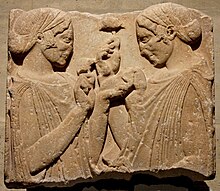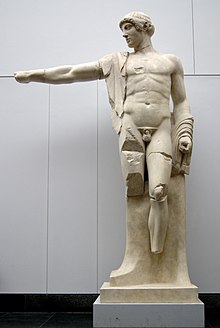
The Parthenon is a former temple on the Athenian Acropolis, Greece, that was dedicated to the goddess Athena during the fifth century BC. Its decorative sculptures are considered some of the high points of classical Greek art, an enduring symbol of Ancient Greece, democracy and Western civilization.

Ancient Greek architecture came from the Greeks, or Hellenics, whose culture flourished on the Greek mainland, the Peloponnese, the Aegean Islands, and in colonies in Anatolia and Italy for a period from about 900 BC until the 1st century AD, with the earliest remaining architectural works dating from around 600 BC.
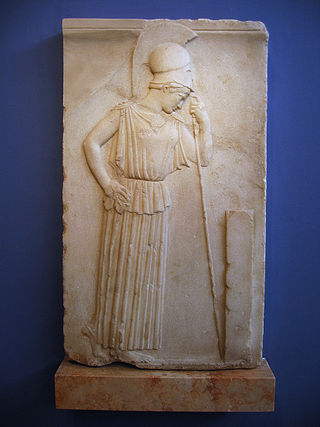
A peplos is a body-length garment established as typical attire for women in ancient Greece by c. 500 BC, during the late Archaic and Classical period. It was a long, rectangular cloth with the top edge folded down about halfway, so that what was the top of the rectangle was now draped below the waist, and the bottom of the rectangle was at the ankle. One side of the peplos could be left open, or pinned or sewn together. In Latin and in a Roman context, it could be called a palla.

Greek temples were structures built to house deity statues within Greek sanctuaries in ancient Greek religion. The temple interiors did not serve as meeting places, since the sacrifices and rituals dedicated to the respective ouranic deity took place outside them, within the wider precinct of the sanctuary, which might be large. Temples were frequently used to store votive offerings. They are the most important and most widespread surviving building type in Greek architecture. In the Hellenistic kingdoms of Southwest Asia and of North Africa, buildings erected to fulfill the functions of a temple often continued to follow the local traditions. Even where a Greek influence is visible, such structures are not normally considered as Greek temples. This applies, for example, to the Graeco-Parthian and Bactrian temples, or to the Ptolemaic examples, which follow Egyptian tradition. Most Greek temples were oriented astronomically.

The sculpture of ancient Greece is the main surviving type of fine ancient Greek art as, with the exception of painted ancient Greek pottery, almost no ancient Greek painting survives. Modern scholarship identifies three major stages in monumental sculpture in bronze and stone: the Archaic, Classical (480–323) and Hellenistic. At all periods there were great numbers of Greek terracotta figurines and small sculptures in metal and other materials.

The Parthenon frieze is the high-relief Pentelic marble sculpture created to adorn the upper part of the Parthenon's naos.

The metopes of the Parthenon are the surviving set of what were originally 92 square carved plaques of Pentelic marble originally located above the columns of the Parthenon peristyle on the Acropolis of Athens. If they were made by several artists, the master builder was certainly Phidias. They were carved between 447 or 446 BC. or at the latest 438 BC, with 442 BC as the probable date of completion. Most of them are very damaged. Typically, they represent two characters per metope either in action or repose.

Kritios was an Athenian sculptor, probably a pupil of Antenor, working in the early 5th century BCE, whose manner is on the cusp of the Late Archaic and the Severe style of Early Classicism in Attica. He was the teacher of Myron. With Nesiotes (Νησιώτης,) Kritios made the replacement of the Tyrannicides ("Tyrant-killers") group by Antenor, which had been carried off by the Persians in the first stage of the Greco-Persian Wars. The new group stood in the Agora of Athens and its composition is known from Roman copies.

The Old Temple of Athena or the Archaios Neos was an archaic Greek limestone Doric temple on the Acropolis of Athens probably built in the second half of the sixth-century BCE, and which housed the xoanon of Athena Polias. The existence of an archaic temple to Athena had long been conjectured from literary references until the discovery of substantial building foundations under the raised terrace between the Erechtheion and Parthenon in 1886 confirmed it. While it is uncontroversial that a temple stood on the central acropolis terrace in the late archaic period and was burnt down in the Persian invasion of 480, nevertheless questions of its nature, name, reconstruction and duration remain unresolved.

The Acropolis Museum is an archaeological museum focused on the findings of the archaeological site of the Acropolis of Athens. The museum was built to house every artifact found on the rock and on the surrounding slopes, from the Greek Bronze Age to Roman and Byzantine Greece. The Acropolis Museum also lies over the ruins of part of Roman and early Byzantine Athens.

Delphi Archaeological museum is one of the principal museums of Greece and one of the most visited. It is operated by the Greek Ministry of Culture. Founded in 1903, it has been rearranged several times and houses the discoveries made at the Panhellenic sanctuary of Delphi, which date from the Late Helladic (Mycenean) period to the early Byzantine era.
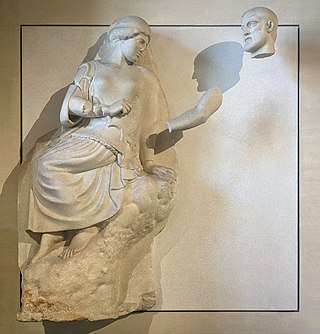
The Olympia Master is the name given to the anonymous sculptor responsible for the external sculpture of the Temple of Zeus, Olympia. From what Pausanias tells us of the dates of the Temple, the Master and his workshop were active between 470 and 457 BC. The two pediments and the series of metopes ascribed to him are the paradigmatic expression of the Early Classical or Severe style of 5th century Greek sculpture.
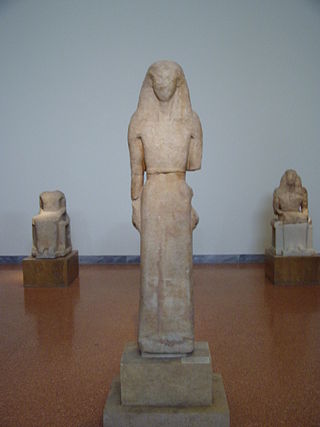
The Dedication of Nikandre is a Greek marble sculpture, made approximately around 650 BCE, held in the National Archaeological Museum, Athens, Greece. Nikandre, a woman from the island of Naxos, dedicated the statue in the temple of Artemis at Delos, the birthplace of Apollo and Artemis. The statue, which was found during archaeological excavation in the 19th century, is one of the earliest surviving korai, or statues of women, and displays one of the oldest inscriptions of Ancient Greek in stone. Its representation and its placement within the existing stylistic periods of Greek sculpture have become the subject of extensive scholarship.

Ancient Greek art stands out among that of other ancient cultures for its development of naturalistic but idealized depictions of the human body, in which largely nude male figures were generally the focus of innovation. The rate of stylistic development between about 750 and 300 BC was remarkable by ancient standards, and in surviving works is best seen in sculpture. There were important innovations in painting, which have to be essentially reconstructed due to the lack of original survivals of quality, other than the distinct field of painted pottery.
The Peplos Kore is an ancient sculpture from the Acropolis of Athens. It is considered one of the most well-known examples of Archaic Greek art. Kore is a type of archaic Greek statue that portray a young woman with a stiff posture looking straight forward. Although this statue is one of the most famous examples of a kore, it is actually not considered a typical one. The statue is not completely straight, her face is leaned slightly to the side, and she is standing with her weight shifted to one leg. The other part of the statues name, peplos, is based on the popular archaic Greek gown for women. When the statue was found it was initially thought that she was wearing a peplos, although it is now known that she is not.

The pediments of the Parthenon are the two sets of statues in Pentelic marble originally located as the pedimental sculpture on the east and west facades of the Parthenon on the Acropolis of Athens. They were probably made by several artists, including Agoracritos. The master builder was probably Phidias. They were probably lifted into place by 432 BC, having been carved on the ground.
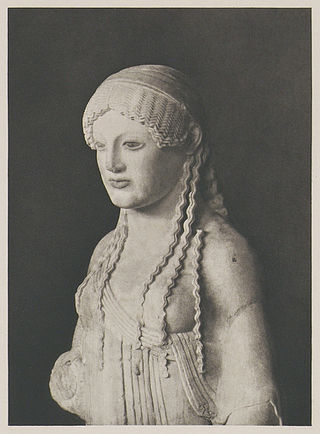
The Euthydikos Kore is a late archaic, Parian marble statue of the kore type, c 490–480 BCE, that once stood amongst the Akropolis votive sculptures. It was destroyed during the Persian invasion of 480 BCE and found in the Perserschutt. It is named after the dedication on the base of the sculpture, “Euthydikos son of Thaliarchos dedicated [me]”. It now stands in the Acropolis Museum.
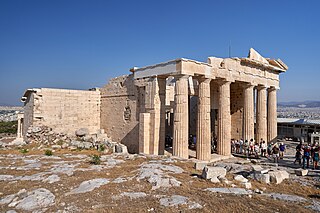
The Propylaia is the classical Greek Doric building complex that functioned as the monumental ceremonial gateway to the Acropolis of Athens. Built between 437 and 432 BCE as a part of the Periklean Building Program, it was the last in a series of gatehouses built on the citadel. Its architect was Mnesikles, his only known building. It is evident from traces left on the extant building that the plan for the Propylaia evolved considerably during its construction, and that the project was ultimately abandoned in an unfinished state.

Pedimental sculpture is a form of architectural sculpture designed for installation in the tympanum, the space enclosed by the architectural element called the pediment. Originally a feature of Ancient Greek architecture, pedimental sculpture started as a means to decorate a pediment in its simplest form: a low triangle, like a gable, above an horizontal base or entablature. However, as classical architecture developed from the basis of Ancient Greek and Roman architecture, the varieties of pedimental sculpture also developed. The sculpture can be either freestanding or relief sculpture, in which case it is attached to the back wall of the pediment. Harris in The Illustrated Dictionary of Historic Architecture defines pediment as "In classical architecture, the triangular gable end of the roof above the horizontal cornice, often filled with sculpture." Pediments can also be used to crown doors or windows.

Classical Greek sculpture has long been regarded as the highest point in the development of sculptural art in Ancient Greece, becoming almost synonymous with "Greek sculpture". The Canon, a treatise on the proportions of the human body written by Polykleitos around 450 B.C., is generally considered its starting point, and its end marked with the conquest of Greece by the Macedonians in 338 B.C., when Greek art began a great diffusion to the East, from where it received influences, changed its character, and became cosmopolitan. This phase is known as the Hellenistic period. In this period, the tradition of Greek Classicism was consolidated, with Man being the new measure of the universe.
